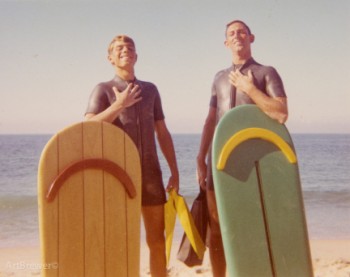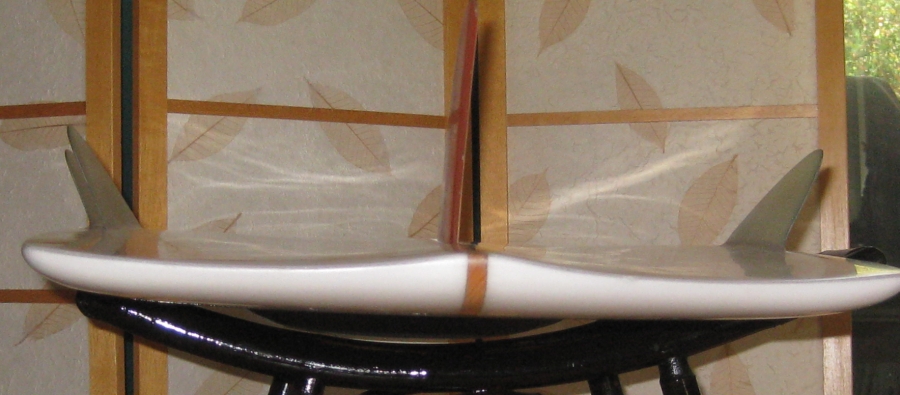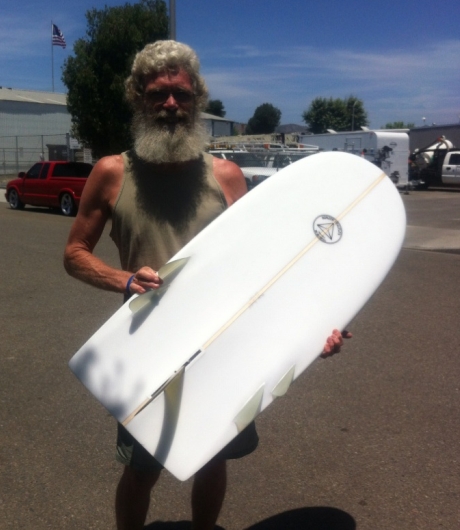A Paipo
Interview with Jeff Quam
E-mail and letter interview by Robert Moynier, May 31 - June 5, 2013,
Laguna Beach, California (U.S.A)
Supplementary questions by Bob
Green, July 7 and 10, 2013
Art Brewer photographs by permission. All rights retained.
(Click on images
to view a larger version)
Jeff
grew up in Laguna Beach, California, an area with a
history of riding paipo boards. His history of experimenting with board
designs begins with necessity, then in response to taunting, and more
recently by seeking to refine a style originally
made by Wally Froiseth, of Hawaii. Jeff has ridden paipo boards for
many years. His relationship with a range of talented shapers is part
of a continuing quest to enjoy surfing and the ocean.
|
1. So some
background... when and where did you start your surfing adventure?
I grew up in Laguna
Beach, California, and so did my Mom. The beach was the best for
providing hours of entertainment for me and the 14 brothers and sisters
I grew up with. I spent most of my free time there and got my first
waves body whomping the shore pound all over North Laguna. The local
corner store sold Styrofoam boards about 3-foot long that I started
riding
and I really got hooked on catching and riding the face of a wave. The
styro boards were shaped a lot like the boards of today, but they had
really long runners on the bottom similar to what some boats have. One
of the first things I did was to cut off about three-quarters of the
leading edge
so it was more like a surfboard fin. That helped, but the biggest
drawback was the belly rash which meant wearing a T-shirt which I
thought was a look for kooks only. So I started looking around for
something to coat the deck to smooth it out. I sprayed the board with
dime store spray paint which melted the outside down leaving it smooth
to lay on, and hardened the board so that they didn't break so much.
Those boards were it for quite a while until I discovered mat surfing,
which was a stand up skill for us.
|
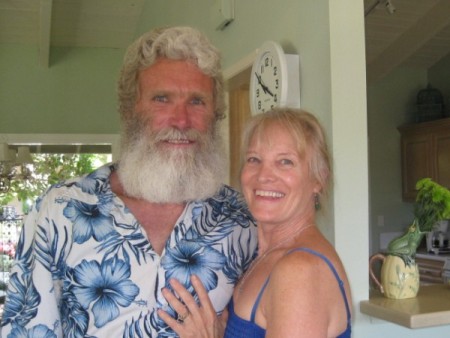
Jeff
and Jill Quam.
Photo
courtesy of Jeff Quam.
|
2. Talk about the Laguna
Beach surfing scene back then. Who were the players: surfers shapers,
lifeguards and others that you surfed with or look up to, and how did
paipo boarding fit into the picture?
My Dad and the guys
he worked with felt that the beach scene was something you protected
your family from because of the drug usage down there. He wouldn't let
me surf (don't ask). When my oldest sister married the Laguna Lifeguard
Captain about four of the guards cornered him at the reception and
asked him to let me surf. A day or two later I was granted the okay and
I
promptly walked down the street and pulled out the surfboard I had been
hiding in the bushes... a castoff 8'6" pig, and took it home. I
naturally gravitated to the lifeguard population and all of them were
into teaching the young guys about the ocean and waves
[see Note 1]. Surfwise Jack Linke was the best.
He loved the water and
was the guy who would take me before, after, anytime to surf
spots south
of Laguna... we had many a surf session together. The paipo was a very
key piece of surfing equipment at that time in Southern California when
every city beach was black balled during the summer (no surfing).
Paipos were allowed however in most swimming/body surf areas. Laguna
had a type of paipo that was unique, the Wally Froiseth-style design,
and had several people that were expert at riding them.
Jeff, you mentioned
that "Laguna had a type of paipo that was unique." Please expand on
that, describe it, and some info about the other folks that were riding
them like the Gordon Theisz, Art Brewer, Mike Armstrong (Army), the Calhouns, and others.
The only other
belly
boards I saw at that time were the ones that looked like the "tanker"
long boards, had a big single fin, pretty narrow square tail and a
constant curve to the outline. I saw them ridden mostly at Huntington
Beach. I noticed a big difference in the performance between the Wally
Froiseth design found in Laguna and this version. Thinking about it now
I think it was like watching the body surfing that I saw in the
late-1950s and 1960s. The guys would take the drop straight off and
lots of
time get rolled up onto the sand. Then sometime in the 1960s the art of
riding the face of the wave came forward, which the Wally Froiseth
design really excelled at.
Two
1965-era paipo boards, (left) a curvy "tanker board" with a large
single-fin and (right) a "Laguna-style" board with relatively parallel
rails, wide tail, two fins and a handle. The
Wardy Surfboards advertisement for an Hawaiian
Belly-Board shows the Wally Froiseth influence in Laguna Beach—a paipo
board design seldom seen in surfing magazine
advertisements of the 1960s (click on the images to see full
advertisements).
|
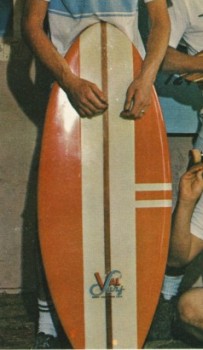
|
|
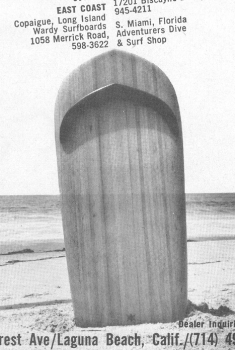 |
(Above
left) Val Surf
[Advertisement]. (1965, June). International Surfing, 1(4), p.
03.
(Above right) Wardy
Surfboards [Advertisement]. (1965, October/November). Surfer
Magazine, 6(5), p. 20.
(Below
left) The Froiseth-style boards line-up at Oak Street, Laguna Beach, in
1964-1965. The board on the left
belonged to Dave Watkins; the center board belonged to Candy Calhoun;
and, the board on the right belonging to
Gordon Theisz was made by Wally Froiseth. Around 1967-1968, Art Brewer
bought the center board from Candy
Calhoun and rode that for a few years.
(Below
right) Gordon Theisz in 1966, with two of the boards he shaped. The
board on the left weighed 14 lbs. and for some reason pearled all the
time. The one on the right weighed 19 lbs. Note the large twin fins
near the tail.
|
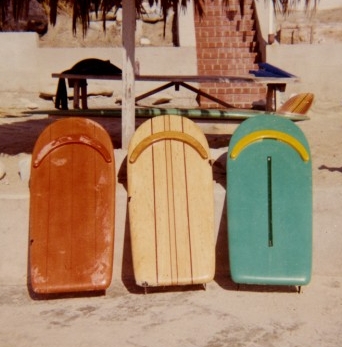 |
|
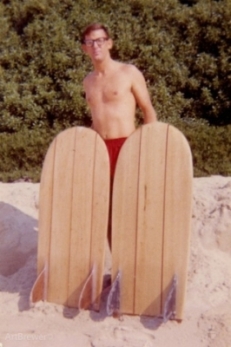 |
Photos
and caption information courtesy of Art Brewer. See additional
information in Special
Notes on Art Brewer.
The surfing area in Laguna at that time was really divided into two or
three areas. Oak Street, which included Brooks Street, was where all
the
great surfers of the day would be. I was down the beach at St. Ann
Street where it was lower key. My exposure to the older crowd for me
was, "Don't make eye contact, stay at least a block away, or there
could
be a price to pay." This meant I could watch, from a distance, but
questions were too close. This may have been mostly in my head, but it
was a very safe position, which was important at the time for me. I was
able to watch the action a lot as my main entertainment at that time
was the beach. I was in awe of the talent down at that end of the
beach. Two guys who really stood out as far as water skills and riding
waves were John Parlette and
Spyder Wills. They were the
best. They had such a feeling
for anything having to do with the beach
skills. [For more information
on Parlette and Wills, see Note 2 and Note 3,
respectively.] I thought they could do anything from Frisbee disk, body
surfing, paipo boarding, skin diving, I thought they could do anything.
Surfing was exciting to me but it almost felt one-sided compared to
what John and Spyder could do with very little.
Below left:
John
Parlette's 5'0" board used for stand-up surfing. He built the board in
1970.
Below right: Spyder Wills with a 5'2"
knee board shaped and glassed by Art Brewer in 1970. It was built
from a stripped down blank. The thickest part was 1-1/2 inches. It
featured a
scooped out deck and a 15" wide tail. It was a great board and Brewer
got to
ride it with Greenough at 6 to 8 foot Rincon twice.
|
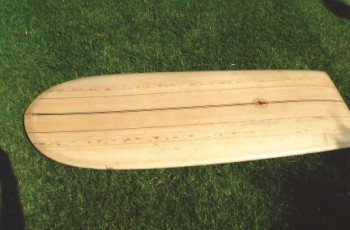 |
|
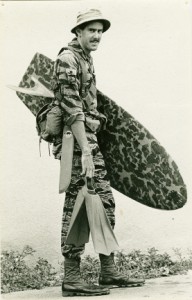 |
Photos
by:
Jeff Quam (left) and Brad Barrett (right) and caption information from
Art Brewer.
(Left) Spyder
at Brook
Street Laguna in 1966 and (right) at inside Oak Street during Summer
1967.
|
 |
|
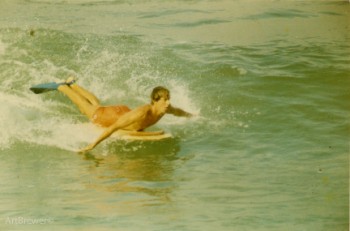 |
Photos
and captions courtesy of Art Brewer.
3. When did you start riding
paipos and what kind of boards were you and the other prone people
riding?
The first paipo I got
to ride belonged to my friend Bill Curland. Bill
Curland's Dad owned a car lot on Coast Hwy 1, by the beach. Bill and I
went to the same primary school together. His Dad turned up with an
early paipo board (from some car deal or something) which we had use
of. I believe it was made by John Parlette as it had his lobster logo
on the tail. Color work, pinline, handle, really a great looking board.
Bill and I would take turns carrying it to the beach as we were little
guys about 13-years-old and the thing was heavy (15 pounds or more). We
had no idea how to ride this board—the tide was usually low as we had
no clue how to call the tide—the rocks would be sticking up, no shape
to waves and we would try and try to get a ride. After seeing John do
his thing at high tide Brooks St—standing up on his paipo—we went at
it the same way. Mostly it was a very good thing the board had a double
10 oz. glass job which made for somewhat of a match for the low tide
rocks we were constantly pearling into.
From there it was back to styro boards and onward to regular stand-up
boards until the early-1980s, when I was living in Central California
and
became friends with Candy Calhoun [see Note
4].
She loved to taunt me and tell me I was a one trick shortboard rider
and couldn't possibly ride a paipo board. When I had had enough of that
I grabbed her favorite board (shaped by Gordon Theisz) and put her
taunting to rest. The paipo feeling stayed in the back of my head and
about 10 years later I had my first modern paipo shaped.
Gordon Theisz
testing a new wetsuit at San Onofre, in 1965, with his Wally
Froiseth board he brought back from Hawaii.
|
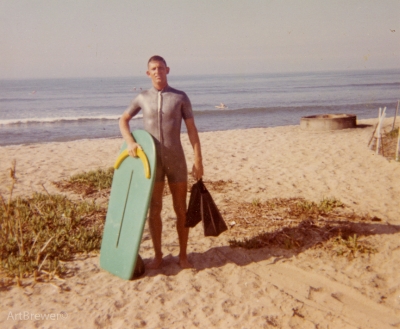 |
|
|
Photo
by Spyder Wills,
courtesy of Art Brewer. Caption information by Art
Brewer.
Gordon Theisz riding a Brook Street winter south swell, ca. 1966. Captured from Spyder Wills's 8mm movie frame.
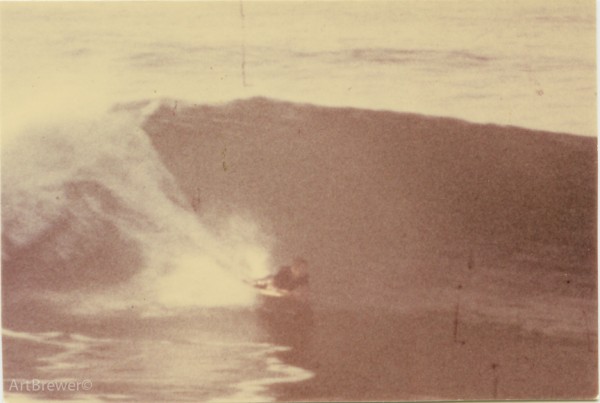
Photo
and caption information courtesy of Art Brewer by permission of Spyder
Wills.
What year did you ride Candy Calhoun's board and
describe that
board and your first board. Who shaped it, what was it, and all?
After
that try I got myself a styro foam board from the dime store that
I rode laying down for a while with fins that I loved until it met the
fate of most styro boards of this time, broken. I think I rode Candy's
board somewhere in the early-1980s. I believe the board I rode was a
Gordon Theisz shape that Candy really liked. I think she gave me her
favorite
board so I wouldn't have any excuses if I totally sucked.
(Below
left) Candy Calhoun riding in Peru on her Wally Froiseth built paipo
board and (below right) Candy Calhoun holding her Gordon Theisz-shaped
bellyboard.
|
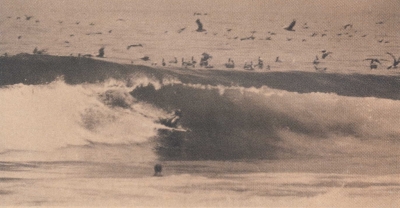
Original caption: "Paipo
Nui has been used all over the world. Candy Calhoun in Peru." In the
next edition, Candy Calhoun wrote to the magazine correcting the caption
noting the board was not a Paipo Nui, but instead "my bellyboard, made by Wallace Froiseth."
Source: Calhoun, Candy. [Letter to Editor] (1965, December). International
Surfing Magazine, 2(1), 71.
|
|
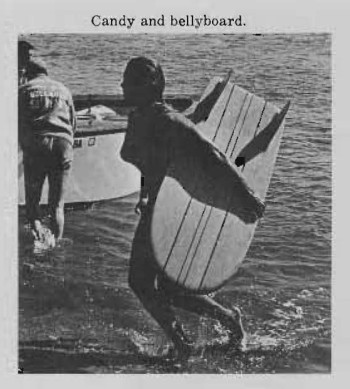 |
(Above
left) Valentine, Val. (1965,
October). Paipo Nui. International Surfing Magazine, 1(6), 51, photo
by Rich Harbour.
(Above right) Unknown. (1964,
May/June). Wake-Surfing
Revisited. Surf Guide, 2(5),
26, photographer not identified.
4. As far as that initial
scene at Laguna, it seems that the paipos in use by the more involved
surfers were variations or replicas of the Wally Froiseth board that
he made for Marge Calhoun in the late-1950s, that she brought home from
Hawaii to Laguna. Is that about right and, if so, was it pretty much
common knowledge where the design came from?
At that time I had
no idea where any of these designs came from. I think I must have
thought that they were always around appearing in the surf shops from
"someplace back there." I had had no idea about any of the past or
current surf stars, only the ones I had direct contact with, mostly my
own age group or a little older. My parents, mostly my Dad, felt that
surfing was something to resist. This left me with no information about
surf stars, surf magazines, all of it.
Below
left: Oak Street board quiver. From left to right are a (1) Wally
Froiseth paipo, (2) Paipo California shaped by Gordon Theisz, (3) Mouse
belly board with a handle added later, and (4) Paipo Nui 1964.
Below right: Gordon Theisz (right) and Dewy (left) with new
wetsuits, San Onofre, Calif., ca. 1965. Dewy
has a Paipo
California board built by Gordon Theisz.
|
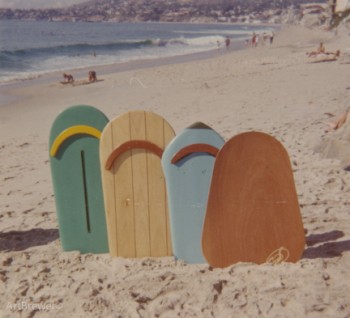 |
|
The
slit in the blue Froiseth paipo board was part
of a speedometer Froiseth had attached.
|
Photos
and caption information from Art Brewer.
5. You mentioned that Gordon Theisz shaped some boards for Hobie Surfboards. What was the connection?
Hobie
Alter, Gordon Theisz and Marge Calhoun were all from Laguna Beach.
Gordon and Hobie collaborated on a few paipo boards based on Wally
Froiseth's design, maybe a half-dozen paipo boards altogether. The
board shown below was built for Marge Calhoun. I stumbled across the Theisz shaped Hobie Paipo board somewhat by accident.
The story begins when I went up to the home of Jeff and Pete Trestle's
parents, in Laguna, to show off my new stick based on the Theisz
design. Then Pete Trestle pulled out the Theisz Hobie from the rafters
in the garage and gave it to me (the board shown below). I was blown
away by this turn of events and rode it a little, mostly at San Onofre,
a rolling type wave since the board really didn't suit the beach break
type waves (pounders, top-to-bottom). Pete told me that the board had
been sitting in the rack at the Hobie Dana Point Surf Shop in the
corner, a lost soul. He bought it for Jeff's Mom to ride at San Onofre.
He also told me the board had belonged to Marge Calhoun which she later
confirmed remembering the green color. Anyway, I had it in my
collection, kind of fearful about riding it too much when I heard it
may be the only one left. Jeff came over from Australia, where he now
lives, and I thought the rightful place for this piece was with the
Trestle family so I handed it off to him at that time.
Jeff Trestle
holding a Gordon Theisz-shaped Hobie-labeled paipo board originally
built for Marge Calhoun.
|
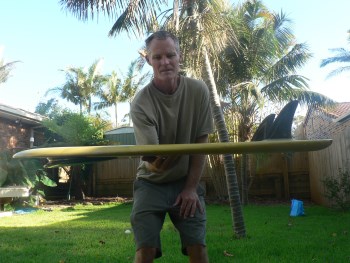 |
|
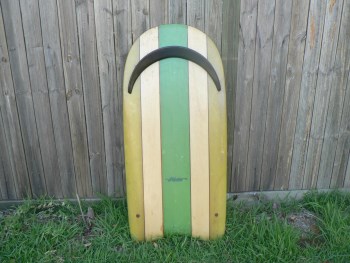 |
Photo
by Bob Green, caption information by Jeff Quam.
6. After Candy Calhoun
shamed you back into paipos, did you keep up with it as part of your
overall surfing repertoire and what type of boards (both paipo and
stand-up) were you riding?
After the time with
Candy, I moved back to Southern California from Central California and
was really into short board surfing, and bigger surf when it showed up.
During this time the Trestle surf break in San Clemente hadn't hit the
limelight so
it was still possible to surf there with a small group on most days.
You had to be able to read the signs about the surf so a lot of days
went uncrowded. Paipo boarding took a back seat to these pursuits. This
all changed when my friends Pete and Punkin knew I was interested in
paipo boards and Pete took me out to the garage and pulled out a
vintage Hobie paipo which once belonged to Candy's Mom, Marge Calhoun.
As soon
as I rode this board at classic San Onofre I was really hooked. I
searched and searched for Gordon Theisz to have a board made and
finally found him just a bit south of me. We got together and he showed
me the latest model he had made which he was kind enough to loan me.
He told me he wasn't interested in making any more, that I should take
it to my shaper and have one made.
7. From then to now, you've
collaborated with a number of shapers on various paipo designs: Gordon
Theisz, Midget Smith, Terry Martin, Donnie Brink and others [see Note 5]. Tell me about those experiences. What
did each shaper bring to your paipo board knowledge and how did they
differ?
My friend and great
shaper, Midget Smith, who I had gotten many great boards from, looked at
what
I had in my hands made a few dry humor comments that he was famous for
("where's the rest of the board, you only want the nose of a long
board?") and off we went to shape the first one, from the nose of a
spare long board blank no less! We made 6 to 7 paipo boards together
and
started to change the design, just little tweaks at a time. The first
was the weight of the boards. The original guys felt the boards had to
have some weight to them to have the "right feel." This was the same as
the long boards of the day, Tankers. They got going with the weight
behind them and they almost have a mind of their own and the rider
hangs on. When we cut the weight of the board down it felt more
controllable.
The next shaper was this young guy just learning to shape. I showed him
the paipo I had at the time and then took it back and told him to put
his ideas into the board. He changed the outline to have a break
towards the tail which allowed the board to redirect or break the
straight line much more. We also cut the weight some on that board
which helped with turning quality. The trade off with this type of
change meant that the board went slower in a straight line but you
could get to places on the wave that were steeper and made the board
and me hanging on going fast in a different way. Terry Martin and I had
talked about paipo design a lot and had talked about making some, but
we ran
out of time (so many boards,so little time). We had worked on some
Min-finned boards (see below) that had some special bottom/rail
configurations that
were the next step. Terry introduced me to this young guy, Donnie
Brink,
and we worked on some of the ideas for the performance model. Josh
Martin then entered the shaping arena having been fully trained and
worked alongside his Dad. Josh was a natural for shaping the paipos as
he can blend, just like his Dad, all the information and make a
wonderful board. Josh really enjoys the art of the hand shape and has
some experience bodysurfing and paipo boarding himself.
What are Min-finned boards?
The Min-fin boards are a design that Terry Martin and I were working on
later seeing the footage of Derek Hynd at Jeffreys' Bay. We choose to
add some contour to the bottom surface by adding small, long shapes to
the bottom (1/2" high x 12" long) to help the board control-wise which
was
different in that we didn't shape anything into the bottom just added
them later, which I could change very easily. The basic bottom design
(concave running the length of the board) is the same we use for the
high-performance, lightweight paipo design. The bottom of the board in
Robert's hands down at the beach has the through-board concave feature
(see figures below).
Jeff and Robert
confer. Jeff holding the Bonzer, Robert holding the Quam-designed Brink
paipo. Note the concave bottom (right photo).
|
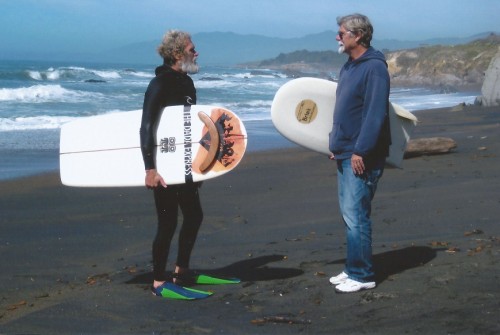 |
|
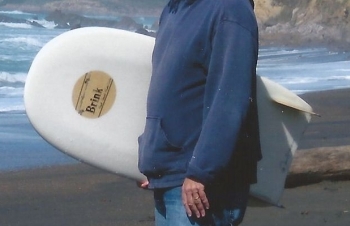 |
Photo
Jill Quam.
Did the
Min-fins theory ride well in practice?
The
Min-fins worked well if I had a bigger budget to have more time to
put into the situation. The whole situation was seat-of-the-pants
engineering. I feel if I had lots of cash to throw at it and
Donny Brink's wild artistic eye a lot could have been discovered. We
were on a completely different track from Derek Hynd in that we were
interested in a board that wouldn't slide so much and would make
maneuvers under the lip, on top of the lip, not usually seen with
everyday surfing. The hang-up around here was the number of surfers
around here and not being able to make radical changes to the angle of
attack to avoid other surfers. The overall feeling of riding with just
the rail as fin is very nice but the sliding doing spinners didn't
really fit into what we had in mind. Donny Brink and I are working on a
design right now that will bring this to paipo riding. More to come—we
are shaping the first one next week to see how it goes.
(Below left)
The waffle
bottom experiment with Donald Brink. (Below right) The Terry Martin
finless collaboration.
|
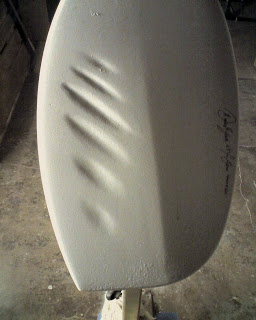
(Above) The "waffle" was
an attempt at balancing out the asymmetrical plane shape—to slow the
water down on one side of the board. The board worked very good on
waves
that were fairly slow (e.g., Trestle). When I rode it on a drivey beach
break
the thing drifted wildly, making for some very interesting positions on
the wave. Drift, baby, drift. More info
here.
(Right) Terry Martin finless. Terry is on the
right.
|
|
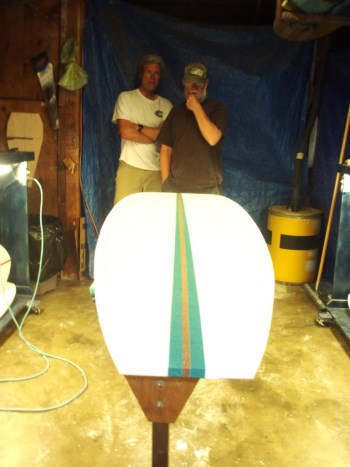 |
Photo
source: Brink, Donald. (2011, August 15) Introducing the midget Martin
Waffle Bottom. Blog Brink. Retrieved July 29, 2013, from donaldbrink.blogspot.com.au/.
8. How about materials?
You've been active in exploring different core processes, particularly
blanks, including poly foam, EPS, epoxy, balsa, and others. What were
some
experiments that went right... or wrong?
I have felt this way
for a long time and I think it fits for paipo boarding too: the board
can only do what it has been designed to do—are you able to get the
most from the design? I have never ridden a paipo board that I walked
away from unhappy. The materials have to blend with what you are trying
to achieve with the design. My personal boards range from light 3 to 4 pound EPS/Epoxy
boards to old school boards easily twice that weight. The EPS
light ones have gotten my attention lately, but I really have a great
time on all of them. My latest one is a chambered balsa old school
model that is a beautiful piece of surf art that I can hardly wait to
ride.
Jeff
Quam "Old
School" paipo.
|
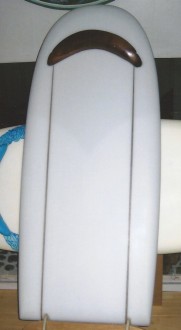
|
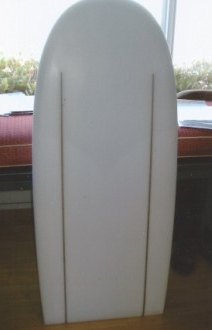
|
Photo
courtesy of Jeff Quam, caption Robert Moynier. |
9. You've recently been
building boards with Josh Martin (Terry Martin's son). Generally they
seem to be about 3'8" to 4'2" (44 to 50 in.), twin-finned, very light,
and equipped with handles. What
are some of the characteristics you feel a good functional paipo will
have in terms of template, foil, rails, thickness and weight that you
feel are universal? Or, is it still a constant process of discovery
and/or personal preference?
Josh Martin and I
have a
great time every time we get together, much like when his Dad was
alive. They both get it as far as the shaper/surfer relationship. One
thing is very important: to give the surfer what they want. Blending
the
vision with the numbers and a certain amount of magic, too. The paipo is
very different from other types of surf sticks. The shaper has to give
up, as well as the rider, a lot of the "stuff" they might have
considered basic to a board. Powering a 51.5 x 21 inch board into a
wave sounds like a big chore but with swim fins and some experience it
takes on a whole different understanding. We had to look at all kinds
of information about body position, where the power was generating
from, things that are unique to paipo boarding.
Burying
the rail, clean wall and coming around the corner.
|
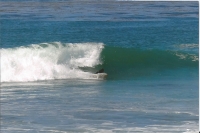
|
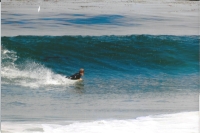
|
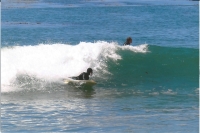
|
Photos
by Jill Quam. |
In your view,
where does the power come from when
riding a paipo? Any other differences between paipo and stand-up board
design characteristics you'd like to comment on?
My idea where the power comes from in paipo has to do with the
straightness of the outline and how flat the rocker is. Both of these
things really make a board that flies, or maybe you just feel like that
as you are so close to the action. NOT!!!! The difference between
stand-up and paipo is very wide. I really love both of them, almost
like
which one of your kids do you like the most? The closeness to the
elements and to the water are right up there to actually ripping a hard
bottom turn off standing-up. For me the high point of surfing has
always been to blend with the wave itself, being as fluid as possible
to
match the wave. With stand-up surfing this can only be done with the
interaction of board and wave. With a paipo, where you are down in the
water, you have all body surfaces in contact with the fluidness. You
have to be fluid or else the wave lets you know right away, very
personal and immediately.
Speed run
|
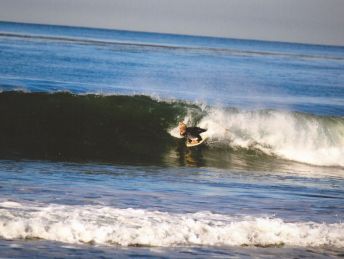 |
|
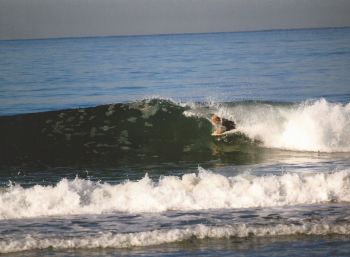 |
Photos
by Mike Chapin and caption by Robert Moynier.
A key aspect for actually riding a paipo board such as these was the
interaction of the handle on the deck to the fins on the bottom. This
connection between the two is very powerful and may be the key to why
this particular paipo design works. I am always amazed at how things
keep moving ahead design wise and how untapped this paipo design
remains.
The example for me is when I rode Robert's Bonzer bottom paipo board,
and right away I could feel the difference from the twins I have, and
in
some wave conditions this difference would be fantastic.
Shadowboxing.
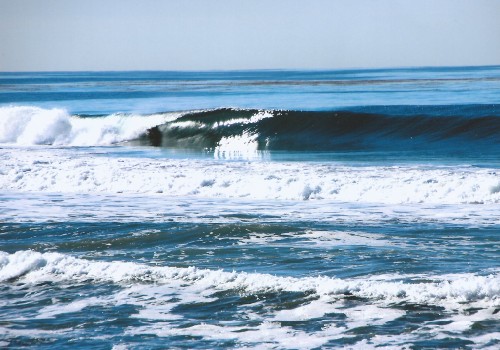
Photo
by Jill Quam.
I'd like to hear more on the interaction between the
handle and the board's fins?
How do you use the fins when surfing?
I think the interaction between the handle and the fins to be very
important. The handle to hang on to with your forearms on the deck of
the board creates a whole bunch of torque for turning and making any
number of adjustments while underway on a wave (in all kinds of
directions, both up and down, side to side, and everything in between.
Similar to the feeling of traction on a slippery surface but more three
dimensional: push, pull, up, down. (See the rock climber going up the
rock
using every surface to move forward.) This solid connection with the
board allows the rider to "hang it all out", as it used to be said, to
put yourself in positions on a wave without a solid connection puts the
rider struggling to hang on. With fins on the bottom and a solid handle
you can place the fins at extreme angles to the face of the wave,
cutting into the face and you get pulled along deep in the tube
hopefully!
One
of Jeff's handles which he makes from a hardwood such as teak,
mahogany, Baltic birch plywood or Divincell.
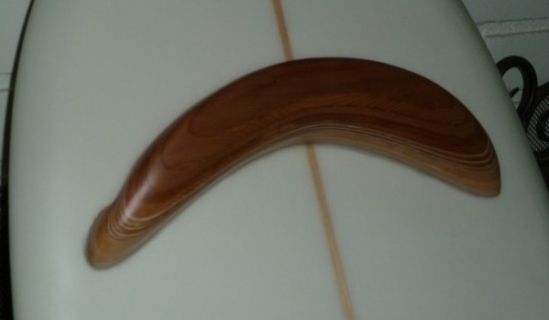
Photo
by Jeff Quam.
10. As part of your project
with Josh Martin you are starting to share some of your designs with
the general surfing population through your new company Laguna Paipos.
Tell me about that—what kinds of
boards are you putting out there and what prompted this move?
What
inspired me to
move in that direction was the people I'd meet at the beach. They would
see a board they had never seen and maybe see me ride a wave or two,
too small for a guy my size (6'2" x 190 lbs.) to catch and get barreled
on,
let's say a knee high wave, come up the beach with a big smile on my
face
and they naturally want to know what was going on. The other was the
volume of guys that had to stop stand-up surfing for one reason or
another, usually back problems, and they never could see themselves on
a boogie. But, when they see my paipo with a wood handle, hard surface,
fins on
the bottom, they can relate much easier to this idea. I have four
general models that are part of my newly established Laguna Paipo line.
These models are not set-in-stone, just guidelines. The small
First/Second Reef
Model (3'6" or so) is for juniors and for when you want to get
very tight in the tube. The Second Reef Model is an old school model
that is very similar to
Wally Froiseth's design. The Third Reef Model is made of balsa wood.
The fourth model, the Honey Buns, is made of very light
high-performance EPS foam.
11. I think it was Jeff
Chamberlain who (correctly) observed that the paipo world has sort of
self-divided itself into two camps, i.e., (1) the wood/ply alaia-type
boards,
including HPD, which are typically finless, very thin, and offer little
in the way of flotation, and (2) the foam and glass group, which can
include
EPS/epoxy as basic core materials, and design wise are finned,
relatively thicker, and involve a more complex building process.
Zealots on both sides claim superior results utilizing their particular
board choice and some will claim that only their board style is a "real
paipo." What do you think about all this and have you had much
experience with the alaia-style paipo or seen much of it in action?
Well... This is a
very tricky question, not wanting to get some angry responses, but here
it goes. I do agree with Jeff's remark in that things have gotten
divided along those lines. I have been around the straight wood ply
crowd and everyone seemed to be having a great time. I think about what
the early riders would have thought, "Piece of ply or foam and
fiberglass?" Personally, I would always change to some material that
proves to have some benefit for performance. Having said that I have
always believed that paipo riding should always be inclusive and not
exclusive and can't we all just get along?
12.
In the overall context
of the surfing world and experience... Where do you think paipo now
sit... Where do you think paipos will evolve to... Will paipo surfing
remain, e.g., a rare niche activity for the surfing purist... Or, are
we on the verge
of
some sort of paipo resurgence?
When I started to
ride paipos the second time, consistently, the only comments I got were
mostly from guys I had surfed with. They would ask, "Did you get hurt?"
or
"Do you always knee board?" or "You really just ride laying down all
the
time?" I think now the interest in different riding styles is at an
all-time high and other points of view are accepted more easily.
13. What kinds of waves do
you enjoy the most and which kinds are your boards best suited?
The variation of
what you can ride on any paipo is pretty amazing even here in
mega-packed Southern California [see Note 6],
but my ideal would have to be sand bottom
point waves. I'm not so sure this has changed any in the last fifty or
so years of my waveriding but now with the paipo board being my main
focus the tube meter seems to be clocking up a lot more time! In these
type of waves the old school boards with flatter rocker have an
advantage over the other designs as they go straight line in the tube
very well.
High speed
barrel chasing
|
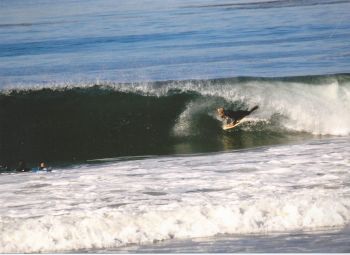 |
|
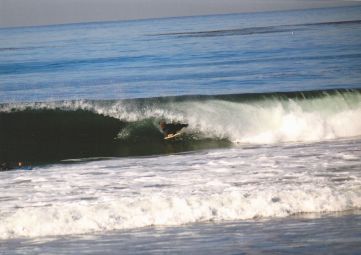 |
Photos
by McDaniel Boys and caption by Robert Moynier.
14. What boards are in the
current Jeff Quam paipo quiver?
Jeff
Quam's quiver, numbered 1 through 9, left to right. All boards are
twin-fins except for #5 (Simmons quad-fin stand-up board) and #6
(Brink tri-fin).
|
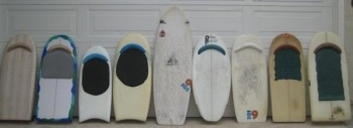
|
|
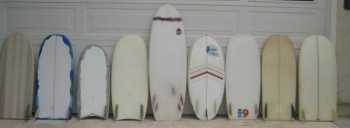
|
#1 Third Reef Model, balsa, unridden, 48 x 20.5 x
2.75 in.
#2 Old School Model, standard poly, 48 x 21 x 1.5 in.
#3 Half Reef
Model, EPS foam and epoxy resin, ~3+ lbs, 42 x 19 x 1.625 in.
#4 Hunny
Buns Model, EPS foam and epoxy, ~4lbs +or-, 48 x 20 x 1.5 in.
#5 Simmons-inspired stand-up board (check similarities between
this board and #4), 65 in.
#6 Donny Brink Model, poly foam, 48 x 20 x 1.625 in.
#7 Ryan Franz Model, 48 x 20 x 1.625 in.
#8 Midget Smith Model
(first one-off of the Gordon Theisz board), 48 x 21 x 1.625 in.
#9 Big
Boy Model (SanO Special),* thick floater for big guys, 50 x 21 x 3 in.
|
*
SanO is a Southern California surfer colloquialism for San Onofre. It
is commonly understood to mean a break called Old Man's, a series of
easy breaking sandbar waves. The area is steeped in Southern California
surfing lore and culture.
Photo
courtesy Jeff Quam.
15. Any new additions to the
Jeff Quam paipo board quiver?
Yes! I just took
delivery of my newest board. It is a five-fin Bonzer shaped by Malcolm
Campbell. I love the way it is riding. It is going to work great in
large waves.
A Bonzer design
shaped by Malcolm Campbell, July 2013.
|
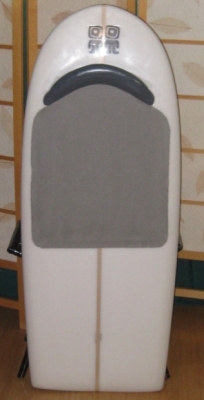
|
(Numbers
in inches unless otherwise stated)
Length: 51
Width: 20.625
Thickness: 1.75
Width one-foot from the nose: 19.25
Width one-foot from the tail: 19.75
Tail width: 17.75
Rocker nose: 1.25
Rocker tail: 0.25
Depth of V's in Bonzer: 0.1875
Fins: a standard 5-fin
Bonzer configuration
Forward pair leading edge: 19.25
Forward pair trailing edge: 14.25
Trailing tip edge of second set: 9
Side fins:
Forward set: base, 4.5; height 2.25
Rear set: base, 5.75; height 2.5
Center fin:
Pictured is the True Ames Bonzer Signature fin, almost
identical to the Wide-base Brewer fin.
Jeff replaced it with a Cheyne
Horan "banana" fin, or the Samurai: height, 6.5; base, 3.5; and rake,
7.5.
|
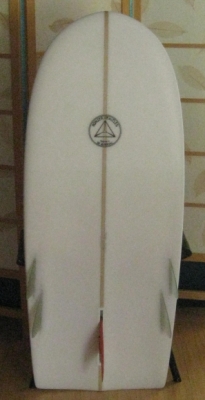
|
Extreme double-barrel concaves
in rear third of the board.
This is a
shorter than normal Bonzer paipo, shorter than Malcolm Campbell
is accustomed to building
because Jeff doesn't favor a super floaty board.
Photos
of the board courtesy of Jeff Quam. |
|
|
|
|
Jeff
Quam proudly holding his brand new Bonzer paipo, Capistrano Beach,
Calif., July 2013.
Photo
courtesy of Kirby Clark.
|
16. What's next for the Jeff
Quam paipo experience?
I plan on spreading
the paipo love to as many seekers as I can come in contact with and try
to move the performance level ahead. Thanks Robert, and I'll see you in
the tube!
Jeff
contemplating Reality, and the deeper meaning of Existence.
There's
only one answer: go back out!
|
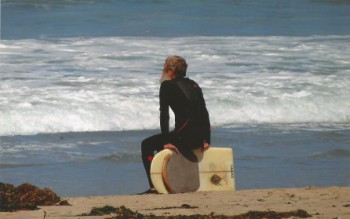 |
|
 |
Photo
by
Mike Chapin and caption by Robert Moynier.
Note 1: Jeff
Quam wrote in more detail about his Laguna lifeguard
experiences in an August 12, 2009, blog piece, Ocean Godfathers,
in the Old Laguna Lifeguard blog. Click here to read the letter: Ocean
Godfathers.
Note 2: Learn more about John
Parlette in a 1994 article appearing in the Los Angeles Times:
Washburn, Jim. (1994, September 20). The Caveman of Laguna Beach. Los
Angeles Times. Retrieved July 29, 2013, from articles.latimes.com.
Note 3: Surfer and filmmaker Spyder Wills was featured
in
the following article: Kampion, Drew. (1969, September). One Step
Beyond... The Legend of Spyder Wills. Surfer Magazine, 10(4),
100-103. Read it at: MyPaipoBoard.org.
Note 4:
Candy Calhoun, along with her sister Robin and mother Marge Calhoun,
were prominent fixtures in the California surfing scene of the early-
through late-1960s. All were accomplished surfers with a string of
contest results including Candy's win at the Huntington championships
in 1963, and her 3rd place showing at the World Championships held in
Peru, in 1965. Candy was also known as a top body surfer and is
credited with being the first woman to bodysurf, and master, both the
Wedge and Pipeline. Through it all, she was a talented and fearless
paipo rider and continued to ride Gordon Theisz design boards up until
the 1990s.
Note 5. Some Internet
links of interest for the following board builders:
- Midget Smith
- Terry Martin
- Hobie Surfboards Shaper Terry Martin,
video by anonymous, at: youtube.com.
- Donald Brink
- Mike Armstrong
- O’Sullivan, Kevin. (2013,
August/September). Before the Herd. The Surfer’s Journal, 22(4).
The article summary on the TSJ website states, "In the early ’70s, Mike
Armstrong departed from the North Shore with little explanation,
despite logging standout performances at Pipeline. Writer Kevin
O’Sullivan caught up with Armstrong on his 860-acre ranch, five miles
inland from Morro Bay, where keeping things “country” isn’t a bumper
sticker, but a way of life." Retrieved August 02, 2013.
Note 6.
It's not all fun and games in sunny SoCal. The first
shot sees Jeff negotiating cross town traffic, sublimely
unaware of the frother that took off in the soup behind him is gaining
speed and closing in. By the sixth picture, Jeff is fully aware he has
a maniac on his hands and enters into a spirited conversation with
same. The next two shots show the end of the line and the opportunity
to continue his discourse with his new found surfing partner.
Crowd Fun. (View sequence from top to bottom
starting with the left column - click on image for a larger view.)
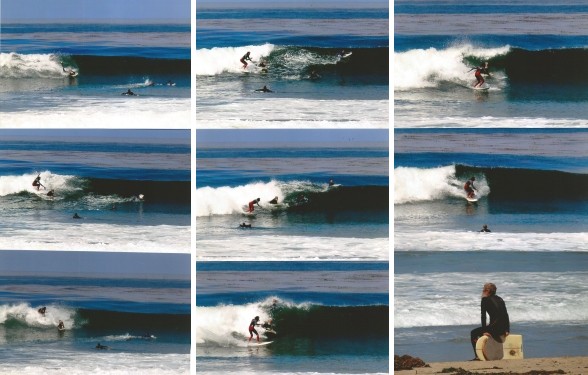
Photos by Mike Chapin.
Special Notes on Art Brewer.
Art Brewer provided early photographs of paipo surfing to
Robert
Moynier with permission for these photographs to be displayed in this
interview. Brewer retains all rights.
Art
Brewer has a
long connection with prone surf craft. In an email to Robert Moynier,
he
noted:
"I started surfing
in 1963, and
continued until about 2000, when I broke my elbow and with the screws
and loss of full extension started to hinder how quick I could get to
my feet. I also grew up riding air mattress and paipo boards until I
met George Greenough and Steve Bigler—they got me riding knee boards
that I continued to do along with surfing until 1977, when I ruined my
right knee skiing. While still in high school I shaped and glassed El
Paipo knee and body boards for Bud Hulst, the original owner. El Paipo
boards were produced for El Paipo by
both Steve Bigler (Machine Scene) in Laguna
and Roy Petrillo of Petrillo Surfboards in Costa Mesa. I personally
didn't like their designs and the boards I were riding were more like
Greenough spoons, some just fiberglass, and others very thin foam and
fiberglass boards." (Art Brewer, personal email to Robert Moynier, February 21, 2012.)
Art Brewer is
recently back in the water with two new Froiseth-inspired
design paipos and has ordered a new Bonzer paipo shaped by Malcolm
Campbell. Needless to say, Art is a stoked
surfin' kid again!
(Below
left) Art Brewer with a Machine Scene kneeboard with a scooped deck
shaped by Steve Bigler, at Thalia St. in 1967. The board measured 6 ft.
x 20 in. x 1.25 in. The board had a small, wide-base Greenough 8 in.
fin
deep and was ridden kneeling and as a stand-up until 8 to 10 inches of
the
tail broke off. The break was just cleaned up and Art continued to ride
it.
(Below right) Art Brewer again riding a mat at Val's Reef, inside
Sunset Beach, ca. 1971.
|
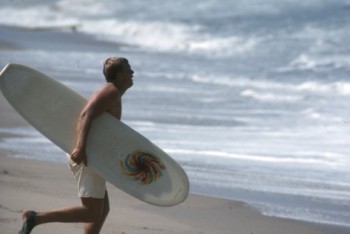 |
|
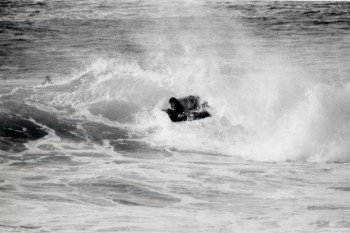 |
Photos
by Brad Barrett (left) and Bernie Baker (right). Caption
information by Art
Brewer.
Other
Items of Note:
- If you are interested in
contacting Josh Martin about any of the paipo models discussed in
Question 10, you may reach him via email at:
jmarshapes@1cloud.com, or by calling 949-533-7641. A website will be
appearing soon.
Some related paipo interviews are listed below.
- Wes "Bulldog" Humpston
Interview
by Bob Green. Questions and e-mail interview by Bob Green. October 31,
2009. Oceanside, California, USA. Skater, surfer and creative artist.
Wes discusses the boards he and his buddies designed, painted and rode;
the transition from fiberglass/foam to wood and back again; the
distinctive wooden handles on the boards that he and his Dogtown
friends rode; and the continuing evolution of belly/paipo boards.
- Robert Moynier
Interview by Bob Green. Questions and e-mail interview by Bob Green. July 5, 2010. Cambria, California, USA. "From Curl Curl to Cambria." From
growing up riding the shorebreak at Curl Curl Robert has returned to
riding prone boards, but with a few twists. He has spent his surfing
life looking for the connections between the paipo/kneeboarding
experience and high performance stand up surfboards.
- Robert Moynier
& Malcolm Campbell Interviews by Bob Green and Robert Moynier. Questions and e-mail interviews by Bob Green and Robert Moynier, September 22, 2011 and October 24, 2011, respectively. Cambria and Oxnard, California, USA. "The Bonzer paipo: two classic designs revisited." Robert
Moynier was interviewed a year ago and at that time was riding stand-up
and at times prone, on bonzer boards ranging in length from 7'8" to 9'.
In his collection he had a short paipo from the 1980s made by Gordon
Theisz. He decided to revisit the design of this board with the
assistance of Malcolm Campbell. The result: two bonzer paipos. Robert
describes his surfing experiences and thoughts on these new boards
which, while modern designs, also have strong links to the past, going
back to Wally Froiseth. Malcolm provides insights into his board design
experience and Moynier's boards. See Part I of the Moynier paipo
interviews above.
(Left)
Jeff's first Josh Martin paipo board, an "Old School" model.
(Far
right) Another Josh Martin board that now belongs to the McDaniel
Boys.
|
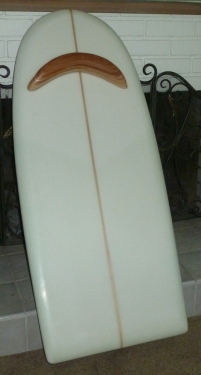 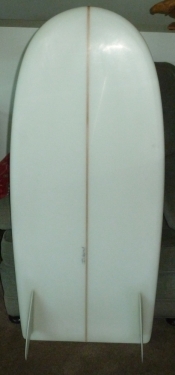
See question #9, for a
close-up image of the handle, or click here.
|
|
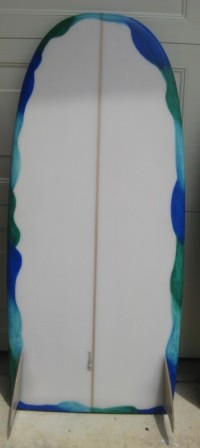 |
Photos
courtesy of Dr. Robert Moynier (left) and Jeff Quam (right).
Jeff
Quam and Kirby Clark, Oceanside Beach, Calif., ca. July 2013.
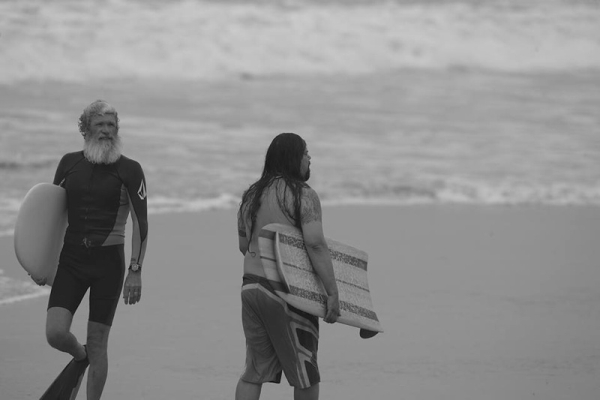
Photo
courtesy of Kirby Clark.
Jeff
Quam driving left under the lip on the Half Reef Model paipo built by
Josh Martin, Oceanside Beach, Calif., ca. July 2013.
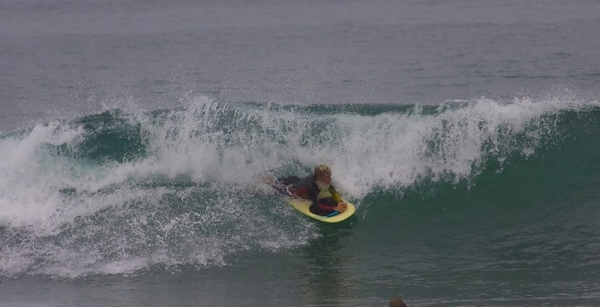
Photo
courtesy of Kirby Clark.
Jeff
Quam paipo boarding some small waves at Salt Creek, ca. June 2013.
In the video Jeff is riding two different paipo boards, the Half Reef
Model and the Hunny Bun Model.
Jeff Quam
Riding Two of His Paipos at Salt Creek on a Small Day (June 2013)
from rodndtube on Vimeo.
Video
by Jill Quam.
|
|
















